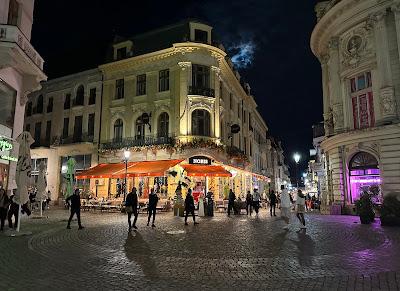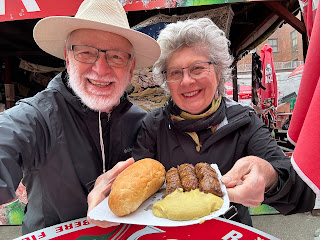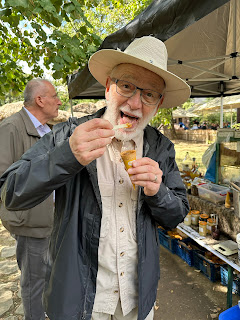 |
| Night vibe in Bucharest’s Old Town |
Our room in the hotel Rembrandt, once a Jewish bank, faces copper-clad rooftops that gleam at sunrise as an all-night busker folds up his boom box after one last rendition of Jail House Rock.
 |
| Sunrise over the Romanian National Bank |
 |
| Rembrandt Hotel |
From the upstairs breakfast room, we watch the morning unfold in Old Town Bucharest, its pedestrian streets quiet until its bars and outdoor cafes reopen for the day.
 |
| Waffles served street side |
Our front window faces the Romanian National Bank, built in 1883. Around the corner is a blue trolly selling waffles and the Cafe Van Gogh with a shaded terrace. A block away is the Beaux Arts-style former Bucharest Stock Exchange, built in the early 1900s, now housing a restaurant and hotel.
In the past, Romania’s capital got a bad rap — known as much for its traffic-clogged streets as its concrete apartment blocks . We gave it a miss on a swing through other parts of the country 17 years ago, but over the last decade much has changed. Subways, trams and buses are clean, modern and efficient, making getting around easy. Even better news: Bucharest has tourists, but not as many as most of Europe’s first-tier cities. And it has retained it’s own currency - the lei- making things less expensive than countries on the Euro.
Filled with Belle Époque architecture that survived World War II, Communist-era destruction and earthquakes, it was known throughout Europe as the Little Paris of the East. What was left standing in the historical center contrasts with the big boulevards, wide streets and Stalinist-style government buildings built by Communist dictator Nicolae Ceausescu.
Ceausescu and his wife were executed by firing squad in 1989 after anti-communist uprisings in Eastern Europe. During his regime, buildings owned by wealthy nobles, businesses, banks etc. were nationalized. Once the government fell, they were returned to the heirs of the original owners and over time, restored.
 |
| CEC Palace, headquarters to CEC Bank |
Among the most famous is the CEC Palace, built in 1897, headquarters to the CEC Bank, and now spectacularly lighted at night.
 |
| Caru’ cu bere |
We were lucky to snag early dinner reservations at Caru’ cu bere, a brewery opened in 1879, nationalized by the communist state in 1949, and renovated in the 1980s with murals, Gothic decorative details and stained glass windows.
As outstanding as the architecture is, it’s the Romanian people - entrepreneurial, energetic and English- speaking- that have made our stay meaningful.
 |
| Vlad and Lorena |
On just our third day in town, we were fortunate to have had dinner with Lorena Duicu and her husband, Vlad, though the Eatwith.com program, a sort of Airbnb for dining. We got acquainted over glasses of their homemade plum brandy, then moved onto grilled eggplant salad, smoked fish, a delicious pork stew simmered in a clay pot, polenta and a homemade plum crumble pie.
It was an evening filled with good conversation about American politics, the war in Ukraine and our mutual love of travel. We were happy to have made a connection like this in a city entirely new to us. Understandably, Romanians were fearful when Russia attacked Ukraine. Kyiv is just 500 miles away. For now, though, life goes on normally in Bucharest which is far away from the fighting.
 |
| Anaid of Freetour.com |
Anaid, a guide with Freetour.com, gave us a short history lesson in a two-hour walking tour covering some of the Christian Orthodox churches that survived the communist era. Most impressive was the 18th century Church of the Stavropoleos Monastery where a few nuns still live.
 |
| Stavropoleos monastery |
The story of the vamprire Count Dracula, she explained, was inspired by Vlad the Impaler (or Vlad Dracula in Romanian), an important ruler and national hero in the 1400’s. The castle in nearby Transylvania, marketed as Dracula’s castle in Bram Stoker’s novel, actually had little connection to the real Vlad, and there‘s no evidence Stoker ever saw it.
 |
| Mici at the Obor Market |
We don‘t eat much meat at home, however, when in Romania…everyone must eat mici, tiny, grilled, skinless pork or lamb sausages, served with a glop of mustard and bread. It's estimated that Romanians eat 440 million annually. You can order them in the fanciest of restaurants, but we went by tram to stand in line with the locals and sample these ($1 each) at Terasa Obor in Bucharest‘s Obor public market.
 |
| Lining up for mici at Obor market |
 |
| Tom samples a honey cone |
Bucharest has beautiful, family-friendly parks. On our way to tour an open air folk village in Herastrau Park, we watched kids of all ages using small, fold-up scooters do tricks in a skate park while their parents relaxed at a cafe across the street, talking and drinking beer.
The Dimitrie Gusti National Village Museum takes visitors through what rural Romania looked like a century ago. The man above was dishing out “honey cones,” like ice cream cones, only filled with a rustic mixture of honey, bee pollen and bee’s wax.
 |
| Sipping visinata at SIP |
Anaid, our Freetour.com guide, left us with a final tip. “Be sure to try Visinata,” she said, Romania’s signature spirit made with sour cherries. They call it Dracula’s blood.





What a beautiful area! Definitely a hidden gem. Thanks Tom and Carol for the descriptions that show the energy and life of the Romanian people.
ReplyDelete